Fabrication of surface hydroxyl modified g-C3N4 with enhanced photocatalytic oxidation activity
Abstract
Graphitic carbon nitride (g-C3N4), a fascinating conjugated polymer, has drawn extensive attention as a metal-free, visible light-responsive photocatalyst in the areas of solar energy conversion and environmental remediation. In this work, the visible light-driven photocatalytic properties of g-C3N4 were enhanced by a simple surface hydroxyl modification without damage to its composite structure. A facile hydrothermal approach was developed and systematically studied. The photocatalytic activity of hydroxyl-modified g-C3N4 was evaluated with regard to the degradation of a group of refractory organic pollutants, phenol, and phenolic compounds in water under visible light. The enhancement of the photocatalytic activity of g-C3N4 after surface hydroxyl modification was assessed by experimental testing results and by theoretical studies using DFT. The following merits synergistically contribute to the improvement: 1) improved adsorption energy between organic pollutants and the surface of the photocatalyst; 2) reinforced hydrophilicity of the surface of g-C3N4; 3) positively-shifted valence-band potential; and 4) improved charge separation in the formation of a heterostructure between g-C3N4 and OH–C3N4. This work provides an effective method to modify a surface with hydroxyl functional groups, so as to improve its photocatalytic activity of the support.



 Please wait while we load your content...
Please wait while we load your content...